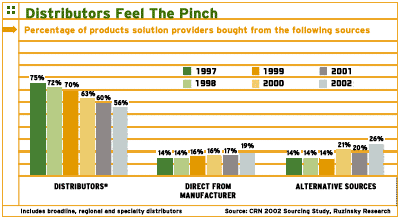Wide Open Field
"I always viewed those businesses as my competition. But now I go to my local CompUSA, which offers the same or better pricing as Ingram Micro or Tech Data, and I get one-on-one service," said Villa, CEO of Via Technology, a San Antonio-based solution provider with more than $3 million in annual revenue. Today, Villa buys 80 percent of his products from alternative sources and 20 percent from broadline distributors. Last year, the numbers were reverse.
"Distributors have forgotten what they're all about," he said. "In the old days, a distributor would form a relationship with the reseller and help him grow. But they've increased their shipping costs and lowered credit lines. I know they have to do what they can to make their numbers but, when times are tough, resellers also get more creative in how they make their numbers."

\
MANUEL VILLA, CEO, VIA TECHNOLOGY
\
Some solution providers find that sourcing game plans using retail outlets, e-tailers and others CAN HELP BUILD a solid offense against rising product prices.
Villa's story mirrors those of a dozen other solution providers interviewed for this article and more than a thousand who were surveyed for CRN's 2002 Sourcing Study. Solution providers are increasingly turning to alternative sources,such as retailers CompUSA, BestBuy and Staples; direct marketers and e-tailers such as CDW Computer Centers, Insight, PC Connection and Ebay; small and specialty distributors; and manufacturers' Web sites,to augment the products and services they buy from traditional broadline distributors. The trend represents a changing dynamic in the channel where solution providers, more than ever, are playing the field for price, ease-of-ordering, faster delivery, hard-to-find or constrained inventory and more personalized service.
"We have to shop around because we need the flexibility," said John Sullivan, president and CEO of First Computer, an Easton, Md.-based solution provider that serves rural communities. Before he buys anything through his main distributors, Sullivan checks product prices through Price Watch.com, a price comparison site where he often finds popular and constrained products from alternative sources for up to 30 percent less than major distributors. "Tech Data and Ingram Micro are huge corporations that are slow to move, slow to adapt to new technologies and slow to bring in new products," he said. "I see a day when a new, virtual distribution channel will replace the channel's current model."
Despite their shifting buying habits, most solution providers say they would rather buy from the broadline distributors, which have remained true to them by refusing to sell products to most end users. But as Tech Data and Ingram Micro continue to raise prices, increase delivery fees, restrict credit lines and limit the number of account reps who regularly visit their customers, solution providers of all sizes say they are forced to shop around.
"We found ourselves in a dilemma because the prices from distributors were higher than the rest of the industry," said Chris Cangero, vice president of Epoch Data, a $10 million full-service solution provider in New York. Cangero cut his distribution purchases by almost half in the past year and now buys direct from IBM, Hewlett-Packard and e-tailers. "We've had to augment distribution because we lost bids to other solution providers who were buying
direct or to customers who were buying product for less on the Internet. Unfortunately, it has come down to price," he said.
Broadline distributors, however, say they no longer see price as a competitive edge. While they try to offer the best prices possible, they say their credit; sales, logistical and technical support; training; and close relationship with manufacturers justify their prices and will preserve their relevance in the channel. "As a value-added distributor, our model doesn't presume we're a price leader," said Stacy Nethercoat, Tech Data's vice president of inside sales and services. "We offer a variety of services to support VARs. To do that means you can't always be a price leader."

Solution providers in turn say that many of the products and services broadline distributors offer don't always fit their changing business models. The distributors, they say, focus too much time trying to please their vendor partners instead of learning the needs of their bread-and-butter customers. "All my Tech Data and Ingram Micro reps want to talk about is how to increase my IBM sales. I tell them I still do millions with IBM, but most of it is direct because I pay what the distributors pay for it," said Grady Crunk, executive vice president of Central Data, a $16 million solution provider in Titusville, Fla.
"Distributors shouldn't waste their time trying to convince the IBMs of the world to run their product through them because the big manufacturers don't need the distributors anymore. [Distributors] have to stop looking for the big kill and concentrate on solutions."
Todd Glassberg agrees. As director of supply chain consulting at Delta Corporate Services, an IT consulting firm based in Parsippany, N.J., Glassberg finds the most cost-effective products for his clients. The rules are changing, he said, as the variety of sourcing options increase. "The sources don't matter," he said.
"It's the rules of engagement that matter."
Although Ingram Micro and Tech Data executives say most alternative sources don't pose a threat to their business models, they have over the past five years been developing VAR communities and special training and education programs to help increase their value to solution providers. "Alternative sources have always been a reality of business," said Bob Stegner, Ingram Micro's vice president of U.S. marketing and channel development. "But from our standpoint, I don't see a large shift of business away from us."
Yet as alternative sources leverage the logistical skills, back- and front-office systems and buying power once dominated by distributors and large systems integrators, solution providers find they can go elsewhere to get services similar to what distributors offer. Because of the variety of choices, solution providers say they carefully weigh each sourcing option before they commit to any purchase. "In a perfect world, I'd want to buy everything through distribution," said Glen Jodoin, vice president of operations at GreenPages, a $16 million solution provider in Kittery, Maine, that has increased its direct purchases from IBM and HP for the exclusive up-front rebates. "But it is cheaper to buy direct from IBM and HP. We have to buy based on who has the best price/value equation."
While broadline distributors remain the preferred sourcing choice, solution providers are finding the price/value equation often leads to other sources.
According to CRN's 2002 Sourcing Study, solution providers bought 56 percent of their products from distributors between July 2001 and June 2002, down from 75 percent in 1997, a 19 percent decrease. Products bought through alternative sources such as direct marketers, retailers, exchanges and corporate resellers and local VARs accounted for nearly 26 percent, up from 14 percent in 1997. Products bought directly from manufacturers increased to 19 percent from 14 percent during the same period.
Tech Data and Ingram Micro, according to the study, also lost significant ground as solution providers' top sourcing preferences. Although they still lead by significant margins, Tech Data, the current overall leader, dropped 19 percent between 2001 and 2002. Second-place Ingram Micro dropped 33 percent.
All other forms of sourcing, except Dell Computer, gained points on the index. HP, IBM and Microsoft took the third, fourth and fifth spots, respectively. Two other distributors posted highly impressive gains. D&H Distributing, Harrisburg, Pa., a full-category distributor focusing on small- and midsize-business solution providers and white-box integrators, showed a 56 percent improvement, due to its 73 percent increase in year-over-year mentions, moving its rank to six from nine. Synnex Information Technologies, based in Fremont, Calif., also posted a gain, coming in with a 107 percent increase.
Jeff Sherman, CEO of Warever Computing, a small full-range solution provider in Los Angeles, decreased his buying from Tech Data and Ingram Micro about six months ago after a series of shipping, credit and return problems. He has since shifted his business to D&H and Synnex, retailers, local resellers and specialty distributors such as Scan Source, a Greenville, S.C., point-of-sale and telephony distributor. "The traditional distribution model is dying," Sherman said. "When I need something, they charge me for every little thing I want to do. It's like they don't want to deal with the little guy."
Alternative sources are taking notice of that dynamic and forming relationships with smaller solution providers. "At the end of the day, VARs want product at decent prices and with a minimal amount of hassle," said Ramin Movahedi, CEO of NextDay Network, a Monterey, Calif.-based aggregator that buys the bulk of its products in volume from Tech Data and Ingram Micro, enabling the company to sell it at equal or lower prices than distributors would charge smaller solution providers.
Like Movahedi, Scott Koerner, executive vice president of Zones, said the Renton, Wash.-based direct marketer is trying to attract more channel business from influencers, consultants and solution providers serving small and midsize businesses. He and other direct marketing executives also said they have had discussions with more top-tier vendors that hope to increase their use of alternative sources to push more high-end products into small and midsize markets. "It's going to be something that's more prevalent," Koerner said. "The channel is becoming more understood today than it was five years ago. It's being recognized as a huge market, and it's a big win for anyone who penetrates it."
That's good news for Villa and other solution providers, who say they'll welcome doing business with any source that can provide them with a competitive advantage. "The source that actually takes the time to tell me about new programs, pricing specials and industry trends gets our mind share," he said. "That's not done enough today. I wish it was."